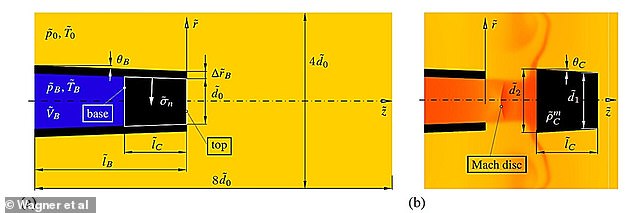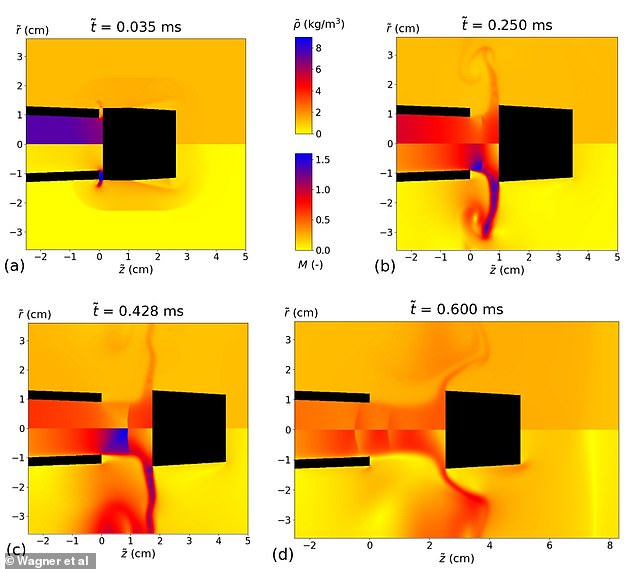The science behind the champagne pop: Study reveals how a supersonic shock wave blasts gas through the bottle at up to 400 metres per second – at temperatures colder than the North Pole!
You'll probably be opening a bottle or two of champagne in a few days to celebrate the New Year.
But what you may not appreciate when you open your buzzer is that you are dealing with a supersonic mechanism that resembles a powerful aircraft.
That's according to scientists in Austria, who have finally revealed the fascinating physics behind the champagne drink.
They say the supersonic shock wave shoots the gas through the bottle at speeds of up to 400 meters per second at -202 degrees Fahrenheit (-130 degrees Celsius) — much colder than even the North Pole.
Meanwhile, the cork is ejected at much slower speeds, but is still fast enough to cause serious injury if directed in the wrong direction.
Time for a physics lesson: Scientists say 'complex supersonic phenomena' occur when you open a bottle of champagne on December 31

The gas that flows from a champagne bottle is much faster than from a cork. The point in this gas flow, where the pressure changes suddenly, is known as the Mach disk
The new study was led by Lukas Wagner, a doctoral student at the Institute of Fluid Mechanics at the Vienna University of Technology.
Wagner and his colleagues say that “complex supersonic phenomena occur” when you open a bottle of champagne.
Champagne bottles are thicker and heavier than regular wine bottles to contain the enormous pressure inside.
This pressure is created by carbon dioxide bubbles produced during fermentation and for this reason the cork must be sealed with a wire cage (“mousselet”).
When it's finally opened, the cork is pushed out by the compressed gas in the bottle and flies away with a loud pop — but the physics behind this was unclear, the team says.
Using complex computer simulations, they were able to calculate the behavior of the ejected cork and the associated carbon dioxide flow.
While the cork is ejected at a speed of about 20 meters per second, the gas flow is much faster, at up to 400 meters per second, the team found.

The picture shows a black cork coming out of a champagne bottle. The champagne cork itself flies away at a relatively low speed – about 20 meters per second
The gas is therefore officially supersonic, meaning it travels faster than the speed of sound (343 meters per second).
There is a point in the gas flow where the pressure changes suddenly – known as the 'Mach disk', also seen in supersonic aircraft.
“Very similar phenomena are also known from supersonic aircraft or missiles, where jet exhaust emerges from the engines at high speed,” said study author Stefan Braun, also at the Vienna University of Technology.
As for the audible pop when opening the bottle that often heralds the start of the celebrations, this is a combination of two different effects.
First, the cork suddenly expands as soon as it leaves the bottle, creating a pressure wave, and second, a shock wave is created by the supersonic gas jet.
This is very similar to the well-known sonic boom phenomenon, which aviation experts are trying to eliminate to make quieter planes.
The study was published on a preprint server arXivmay be important for other applications involving gas flows, such as ballistic missiles, projectiles, or missiles.

The cork comes out at much slower speeds, but is still fast enough to cause serious injury if directed in the wrong direction (archive photo)
“In many technically important situations, you are dealing with very solid flow bodies that interact strongly with a much faster gas flow,” the authors concluded.
Another team of researchers earlier this year revealed why the bubbles in champagne fizz completely straight while beer does not.
He found that larger bubbles and the addition of special proteins in champagne stabilized the chains of bubbles, allowing them to rise in a straight line.
Other research has shown that there are more bubbles in champagne than in beer, when comparing the same volume of both drinks.
This is because Champagne and other sparkling wines contain twice as much dissolved carbon dioxide as excess sugar.
(Tags for translation) Daily Mail
